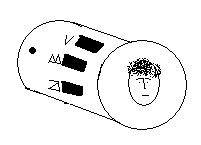After an unplanned, rather lengthy, and otherwise unremarkable hiatus (*yawn*...), postings will continue until morale improves. In the interim I've begun working at the University Museum in Philadelphia once more.
I recently discovered LibraryThing, an easy and addictive online book-cataloguing site, whose developer's interests, incidentally, "run to ancient history, Greek and Latin." It's easy to lose oneself in, and I spent quite a bit of time cataloguing while home for Thanksgiving, though the task is still far from complete. I also set up a widget in the sidebar below the links that shows random books from my library for amusement.
I'd also like to offer belated congratulations to Dr. Mercado! As I consider setting foot on that path in the not-too-distant future, it's encouraging to see such successes emerging from the end of the trail.
For whatever reason I just now recalled a sign I saw from the window of a bus from Assisi to Perugia, early in September 2005, for a bar called "Pantarei," which I thought was amusing at the time (Heraclitus' famous dictum, panta rei, means "everything flows"), but I see now is not so uncommon.
Saturday, December 09, 2006
Tuesday, January 24, 2006
Catapult from Casalbordino
I was inspired by Angelo's post on Oscan abecedaria to dust off the old keyboard; for the future remain many exciting episodes from Italy and some brief things about the APA/AIA convention. The inscription that concerns me here is the following (format snagged from Sauvage Noble):
"Rix Fr 13
The letters that accompany what were originally ten holes evenly-spaced around the cylinder therefore indicate intervals of 36 degrees up to 324 (360 and 0 being of course the same). This division would give the artillerist a chance to adjust the tension with some degree of regularity, based on prior experience (probably the previous shot!). The cylinder probably dates to the period of the Social Wars, ca. 90 BCE, when many of the Italic tribes took arms against Roman hegemony.
"Rix Fr 13
Bronze cylinder, Casalbordino:
a b g d v z ḥ [i] k
Aside from 〈a〉, all the letters are/can be consonantal, without regard for voicing."
It's a bronze cylinder, found at Casalbordino in Abruzzo, now in the Museo Nazionale in Chieti.
The letters that accompany what were originally ten holes evenly-spaced around the cylinder therefore indicate intervals of 36 degrees up to 324 (360 and 0 being of course the same). This division would give the artillerist a chance to adjust the tension with some degree of regularity, based on prior experience (probably the previous shot!). The cylinder probably dates to the period of the Social Wars, ca. 90 BCE, when many of the Italic tribes took arms against Roman hegemony.
Wednesday, January 04, 2006
Trebula Mutuesca
Faithful readers may remember that I was on a dig in Italy way back in August. Now that I'm home and starting to get my act together, I can offer some photographs from my travels. The site is Trebula Mutuesca, site of a Sabine sanctuary to the goddess Feronia, near the modern village of Monteleone Sabino, some ways north of Rome in the Sabine Hills. The excavation is in the area directly below the assumed site of the temple. A terrace wall (seen clearly in the first picture below) separates the temple area from a colonnaded approach (seen in the second picture).


Interior designer by profession, archaeologist by passion, Leo uncovers a cache of five Roman Republican-era bronze coins: Lindsay, our site director Giulio, and Pierangelo take a break in the shade:
Lindsay, our site director Giulio, and Pierangelo take a break in the shade:

A single worked tufa block from a workshop at Falerii Veteres (modern Civita Castellana). Apparently used as fill during construction of the terrace and colonnade.

Giulio and Stefania inspect the site:

The terrace wall in the near foreground, the colonnade stretching away in the center, bordered on the left by a drain and the right by a wall.

Interior designer by profession, archaeologist by passion, Leo uncovers a cache of five Roman Republican-era bronze coins:
 Lindsay, our site director Giulio, and Pierangelo take a break in the shade:
Lindsay, our site director Giulio, and Pierangelo take a break in the shade:
A single worked tufa block from a workshop at Falerii Veteres (modern Civita Castellana). Apparently used as fill during construction of the terrace and colonnade.

Subscribe to:
Comments (Atom)


